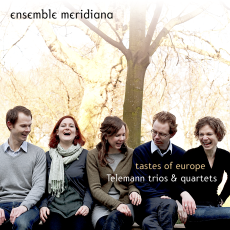Ensemble Meridiana - Tastes of Europe - Audiophile Audition
You would think that Telemann wrote so much music-published and
unpublished, performed in modern times and yet to be performed-that he
wouldn't need spurious attributions to swell his catalog of works. And
yet this disc includes a lively and engaging trio that's about as fine
as anything on the program and which - though attributed to Telemann
until very recently - is actually the work of his contemporary, Pierre
Prowo (1697-1757). Born in Altona, where he worked as organist and
composer all his life, Prowo would have been familiar with the chamber
music of Telemann, who lived and worked in nearby Hamburg. So on a
number of scores, the attribution is not so surprising after all,
especially since the finale of Prowo's Trio in D Minor is a
smart little dance in the Polish style, an imitation that would
naturally point to Telemann, who had studied and adapted Polish folk
music since his early days as Kapellmeister at Sorau in western Poland.
Interestingly, none of the Telemann works on this disc are directly
influenced by Polish music, but they do display the "mixed taste" that
was supposed to characterize German music of the time, a style that
blended native musical elements with those of France and Italy-hence the
album title The Tastes of Europe. Ensemble Meridiana gives us a
sampling of Telemann's chamber music that reflects these different
national styles, starting with the relatively early Trio in E Minor.
Here, French influence is so rife that Telemann himself said the work
"smell[s] of France," from the French markings for each movement right
down to the inclusion of French dance forms, a rigaudon (marked Grave) and passepied (marked Allegrement). The trio is scored for two dessus
(high-pitched instruments), apparently unspecified in the score; in
this performance, the parts are taken by violin (Sabine Stofer) and
recorder (Dominique Tanguely).
Telemann's Trio 3 and Trio 7 are somewhat later and display
an even more conscious blending of styles. Along with French elements
are clear references to Italian musical tastes. For example, in the Andante
third movement of Trio 3, "the instruments become singers of an
(Italian) aria," while the last movement is a minuet in rondo form.
The two quartets (concertos) from around 1730 represent a special case. Classified as Sonata auf Concertenart,
they were among the first of a trendsetting genre that melded elements
of the sonata and the Italian concerto. Here, the solo instruments
(recorder and oboe) play in the manner of concerto soloists, alternating
with the ritornello supplied by violin and basso continuo.
Strikingly and somewhat unexpectedly, Telemann introduces a strict
four-part fugue as the second movement of the Concerto in A Minor-a perfect example of the mixed style, as the composer revisits his North German roots.
Ensemble Meridiana is a collection of five musicians from different
parts of Europe who linked up while studying at the Schola Cantorum in
Basel. Besides violinist Sabine Stofer and recorder player and
bassoonist Dominique Tanguely, they include Sarah Humphreys (oboe), Tore
Eketorp (viola da gamba), and Christian Kjos (harpsichord). Despite
having been around for only five years, the group has won several
prestigious awards, including first prize and audience prize at the
Fourth International Telemann Competition in Magdeburg (2007). One can
hear why. They play with style, energy, and conviction; by any measure,
this is lovely ensemble and solo playing.
As usual, the Linn engineers provide sound that is both very present
and wonderfully transparent. In surround sound, the players seem to
form an arc that extends beyond the front speakers, while the rear
speakers effectively create a sense of the space in which they play (St.
Margaret's Church in York). Altogether, an enticing musical experience
and highly recommended.

